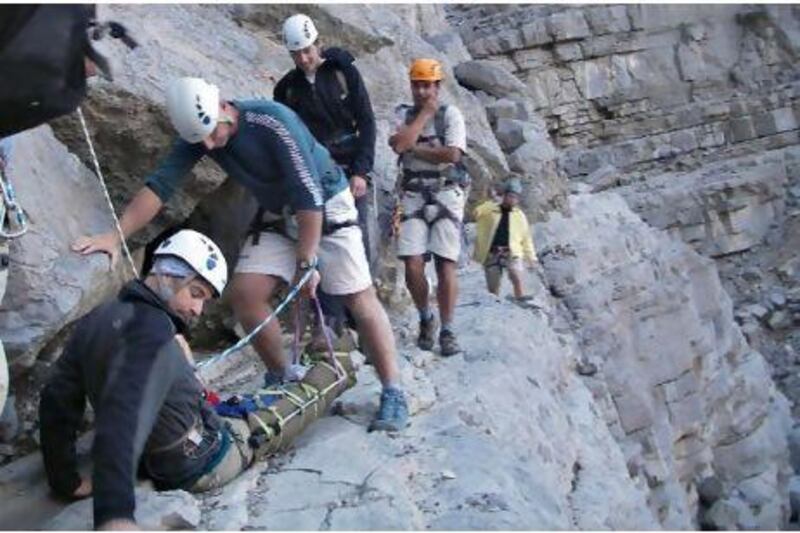RAS AL KHAIMAH // When an Australian hiker was stranded overnight on the steep slopes of a Ras al Khaimah mountain, it triggered a 24-hour rescue mission that galvanized the country's mountaineering community.
Cameron Brooks, 43, knew he would be unable to walk further when he lost his footing on loose gravel and fell heavily head over heels, suffering a fracture in his right leg. He was one of 17 paticipating in a two-day guided hike of the Stairway to Heaven route in Wadi Ghalilah on Friday. The route, which takes an average of 10 to 12 hours and is easily lost, was especially difficult at the weekend because of heavy rain and fog.
After Mr Brooks fell, the group called for help and within an hour, more than 20 members of the mountaineering community - a mixture of experienced climbers and outdoor education professionals - began the rescue mission.
On the day of the accident, 14 people made the ascent to offer assistance but most returned after dark once it was clear that nothing could be done that night. Seven men stayed with Mr Brooks through the night to offer medical assistance on a mountain where temperatures can plummet below zero. His symptoms - a suspected concussion and fracture of his lower right leg - rendered him unable to continue the two-hour trek to the base of the wadi. Helicopter assistance would have been impossible because of the narrow location where Mr Brooks fell.
Climbers hiked early on Saturday to reach Mr Brooks and those who stayed with him. "You kind of hope that if it ever happens to you that everyone else will be there so it's kind of this unspoken community," said Nat Churchill, 30, a British trekker who helped with the rescue. "I've seen it before and we've all got it back at home. Here you might not have a traditional mountain rescue team so people are ready to get up and they go, even at 3.30 in the morning."
The rescuers put Mr Brooks on a stretcher andtook turns to carry it on the steep descent. In places too steep for the stretcher, Mr Brooks was lowered by rope, on occasion as far as 30 metres.
"We don't want to have another casualty and so we've got to look after everybody," said Pete Aldwinckle, a RAK-based rock climber who was on-hand to help. "The thing that was amazing … is within a couple minutes of making a call you had 20 people ready to go. Everybody came out."
They managed the descent in about six hours. "We've got people from all over and they've never rehearsed together but I can't believe the way they managed it all," said Ms Churchill. "I've never see something run so like clockwork before. I've worked in places where you don't have that backup system and you really have to appreciate it. You'd never turn around and say 'I'm not going'. What if it's you up there?"
Once back at base, Mr Brooks was taken for treatment at Rashid Hospital in Dubai.
The hike was organised by a Dubai-based adventure group to promote a talk by Dan Mazur, a Himalayan mountaineer whose climbing team sacrificed their chance to reach the summit of Mount Everest by rescuing another climber who had been left for dead. Mr Mazur joined the two-day hike in RAK and returned with other hikers on Saturday night.
Philip Dale, 30, a British RAK-based mountain leader on the rescue expedition, said only experienced climbers should attempt the Stairway to Heaven. "It's steep and very loose rock and it's not somewhere that your average novice or hill walker would go," said Mr Dale. "It's a popular route but it needs to be done by experienced people. It's steep, loose and exposed.






